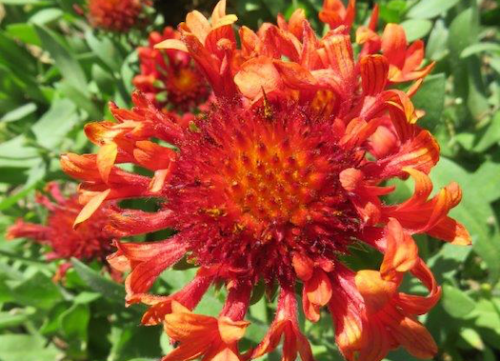
I LOVE perennials because they don’t need constant replanting like annuals. They’re ideal for dividing for extra plants and most can be readily grown from seed.

One perennial that really brightens gardens for months on end is Gaillardias, which belongs to the Asteraceae family and is named after the 18th century botanist Gaillard de Charentonneau. Pictured here at the Horticultural Society of Canberra’s Trial Garden in Bruce is Gaillardia Fanfare, a native to north and south of the US. Its colours are featured on the flag of Texas.
ONE of the most popular hedging plants in Britain and Europe is Griseliania littoralis, and yet I have rarely seen it for sale here. Littoralis in the name means “growing by the sea”.
Originating in the extremes of climate in NZ, where it is known as Kapuka, it is a hardy drought-tolerant plant that can, in ideal conditions, grow to 10 metres tall and yet it will stand hardy clipping to keep it to two to three metres.
Its small, greenish flowers of spring to midsummer are followed by black berries in autumn/winter.
WHILE the autumnal leaf colour of deciduous trees turns heads, there is one evergreen tree that puts on a magnificent show from midsummer through to autumn; namely Ceratopetalum gummifera or more commonly the NSW Christmas Bush.
The gummifera refers to the large amount of gum extruded when the bark is damaged. It is native to Australia and New Guinea and renowned for its red autumnal colours at that time, although it is not the leaves that change colour.
The white star-like flowers in spring are followed by beautiful red sepals that enlarge up to 10 millimetres across after the fruit has set. It was first described by the English botanist Edward James Smith in 1793 in his treatise “A Specimen of the Botany of New Holland”.
AN early morning visit to Mount Ainslie will be rewarded with an unforgettable kaleidoscope of red, yellow and orange-coloured leaves. In Tumut they’ve just had the Festival of the Falling Leaf to celebrate the occasion; maybe we could do the same here as an added attraction for visitors to Canberra?

HERE’S a way to get extra plants for no cost. Plants that may be a few years old will have shoots that are close to the ground and may have taken root. Or you can purposely pin down branches close to the ground and cover with a layer of soil. They soon grow roots that can be carefully dug up in late spring and potted up. Alternatively, carefully dig up and plant elsewhere directly in bare spots in the garden. Lavender and rosemary lend themselves to this method.
Jottings…
- Heino Lepp will speak on mushrooms and other fungi at the next meeting of the Horticultural Society of Canberra, Wesley Church Centre, Forrest, 7.30pm on Monday, May 20. All welcome.
- When buying trees at garden centres it’s always a good idea to pick them up by the pot and not by the trunk.
- It’s an ideal time to select deciduous trees for their autumn leaf colour before the leaves fall.
- Leave old flower heads on hydrangeas through winter. They help protect emerging buds from frost. Prune back in spring.
- Last reminder to plant or dig up and relocate bulbs.
- It is a good time to dry herbs. The easiest way is to tie in bunches and hang in a cool, dry spot, ie the garage.
Who can be trusted?
In a world of spin and confusion, there’s never been a more important time to support independent journalism in Canberra.
If you trust our work online and want to enforce the power of independent voices, I invite you to make a small contribution.
Every dollar of support is invested back into our journalism to help keep citynews.com.au strong and free.
Thank you,
Ian Meikle, editor




Leave a Reply